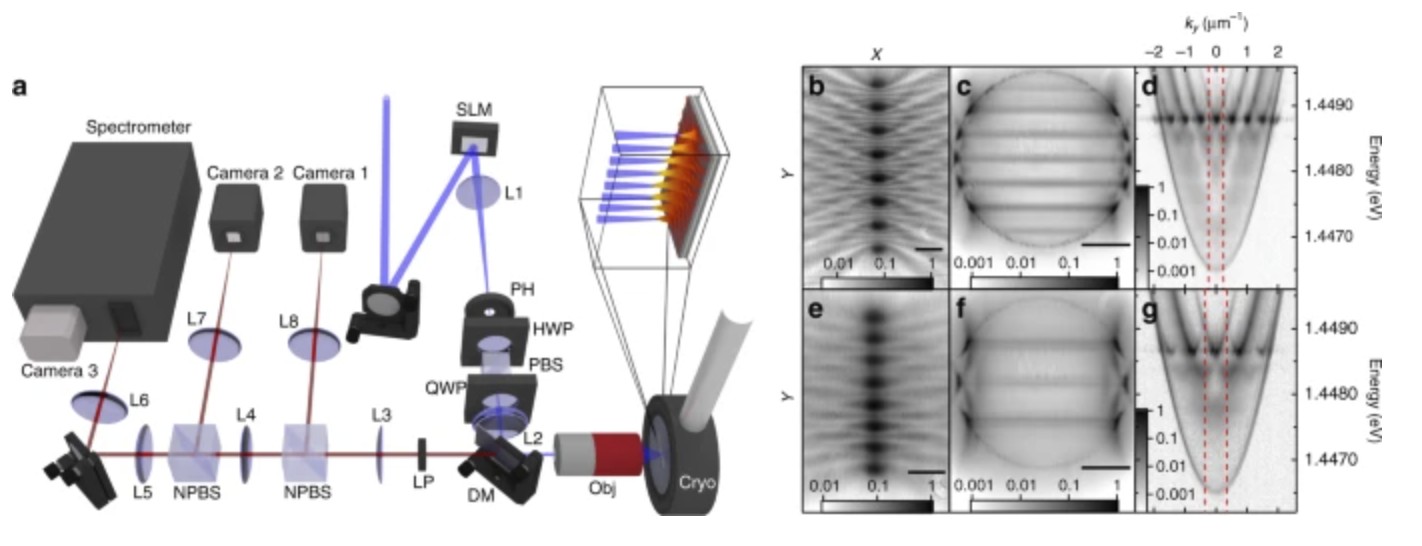Researchers at the Hybrid Photonics Laboratories in Skoltech and University of Southampton (UK), in collaboration with Lancaster University (UK), have demonstrated a new optical method to synthesize artificial solid-state crystal structures for cavity-polaritons using only laser light. The results could lead to realization of field-programmable polariton circuitry and new strategies to create guided light and robust confinement of coherent light sources. The results were recently published in the journal Nature Communications.
Creating artificial lattices for quantum particles permits us to explore physics in an environment which might not be conventionally found in nature. Artificial lattices are especially appealing since their symmetries lead often to exactly solvable models and transparent understanding of their properties. Designing them is, however, a challenging task with limited flexibility. Materials need to be irreversibly engineered to get the job done and even optical lattice techniques for cold atoms cannot attain arbitrary lattice shapes.
The researchers, Dr Lucy Pickup (Southampton), Dr Helgi Sigurdsson (Southampton and Skoltech), Prof Janne Ruostekoski (Lancaster), and Prof Pavlos Lagoudakis (Skoltech and Southampton) recognized and overcame this challenge by developing a new method to create arbitrarily shaped and reprogrammable artificial lattices using only structured laser light. The “reprogrammable” feature meant that the cavity-polariton system could be changed from one lattice to another without the costly need to engineer a new system from scratch.
When laser light hits a semiconductor quantum well it excites a lot of electrons, holes, and bound states of the two known as excitons. When the quantum well is put between two mirrors, forming a trap (or a cavity) for the photons, some of the exciton particles start becoming “dressed” in photons, forming new exotic half-light, half-matter quasiparticles known as exciton-polaritons or cavity-polaritons.
Exciton-polaritons are very interactive and bounce frequently off one another. However, they also bounce off normal electrons, holes, and excitons in the background around them. The researchers could then show that by applying laser light in a geometrically structured fashion the exciton-polaritons started bouncing of the excited electrons, holes, and excitons following the shape of the laser. In other words, the exciton-polaritons started experiencing a synthetic potential landscape imprinted by the laser.
The laser generated potential landscapes are only felt by the exciton-polaritons and not the photons inside the cavity, making the system uniquely different from photonic crystals. By creating a laser pattern with translational symmetry, the researchers produced the fundamental signature of solid state systems, the formation of crystal energy bands for exciton-polaritons, just like one would observe for electrons in solid state materials.
“The results open a path to study dissipative many-body quantum physics in a lattice environment with properties that cannot be reproduced in normal Hermitian quantum systems,” Dr Lucy Pickup, article co-author, says.
Dr Helgi Sigurdsson adds: “It is an exciting development for the relatively new field of non-Hermitian topological physics.”
The produced bands could be reconfigured by simply adjusting the laser pattern, permitting a non-invasive method to access quantum physics in artificial lattices. The results could be useful in a variety of applications from optical based communications and information processing, to high sensitivity detectors for biomedical purposes and topologically protected lasing. The results also open a path to study fundamental many-body lattice physics in an open (non-Hermitian) quantum environment.

